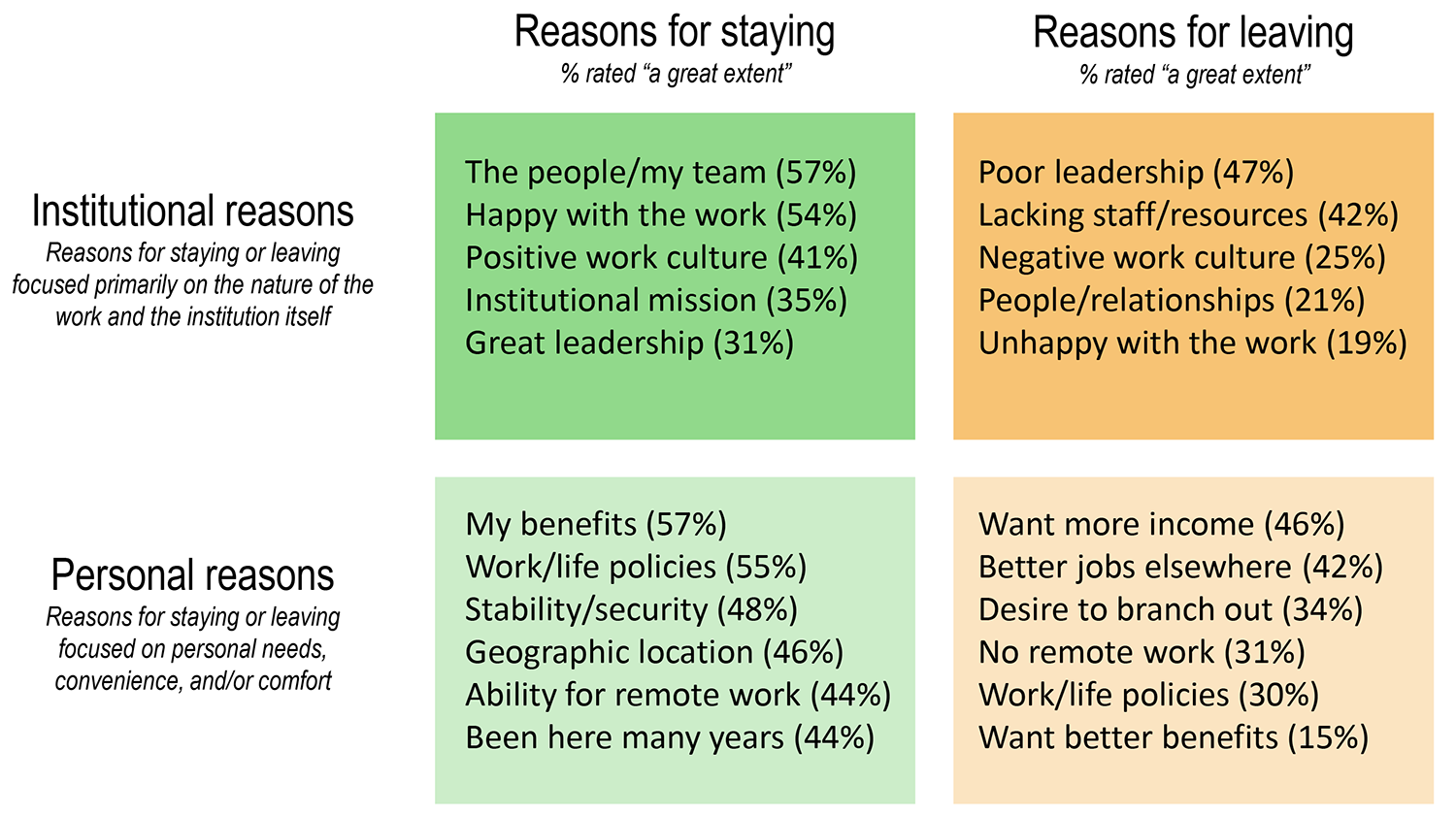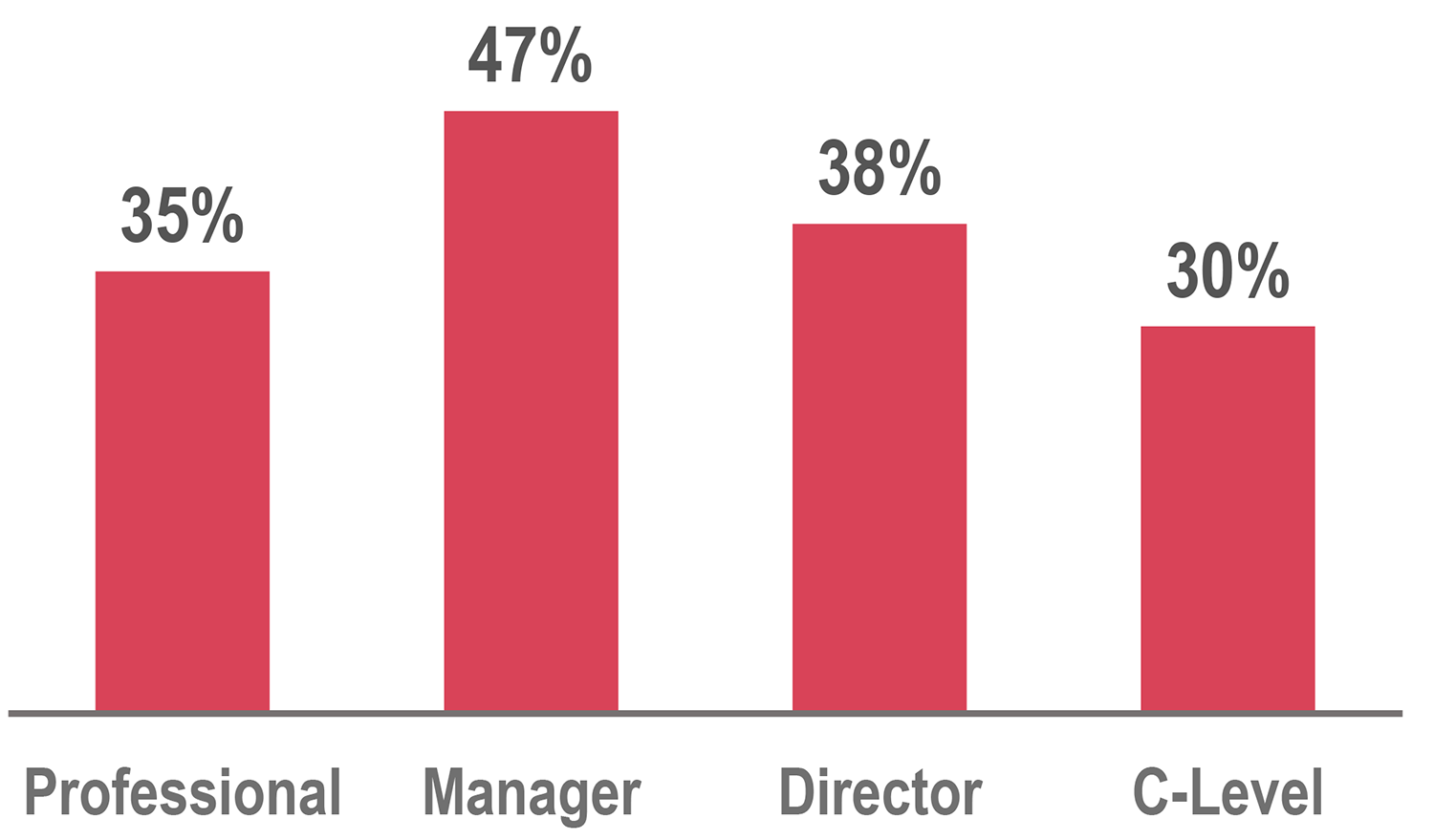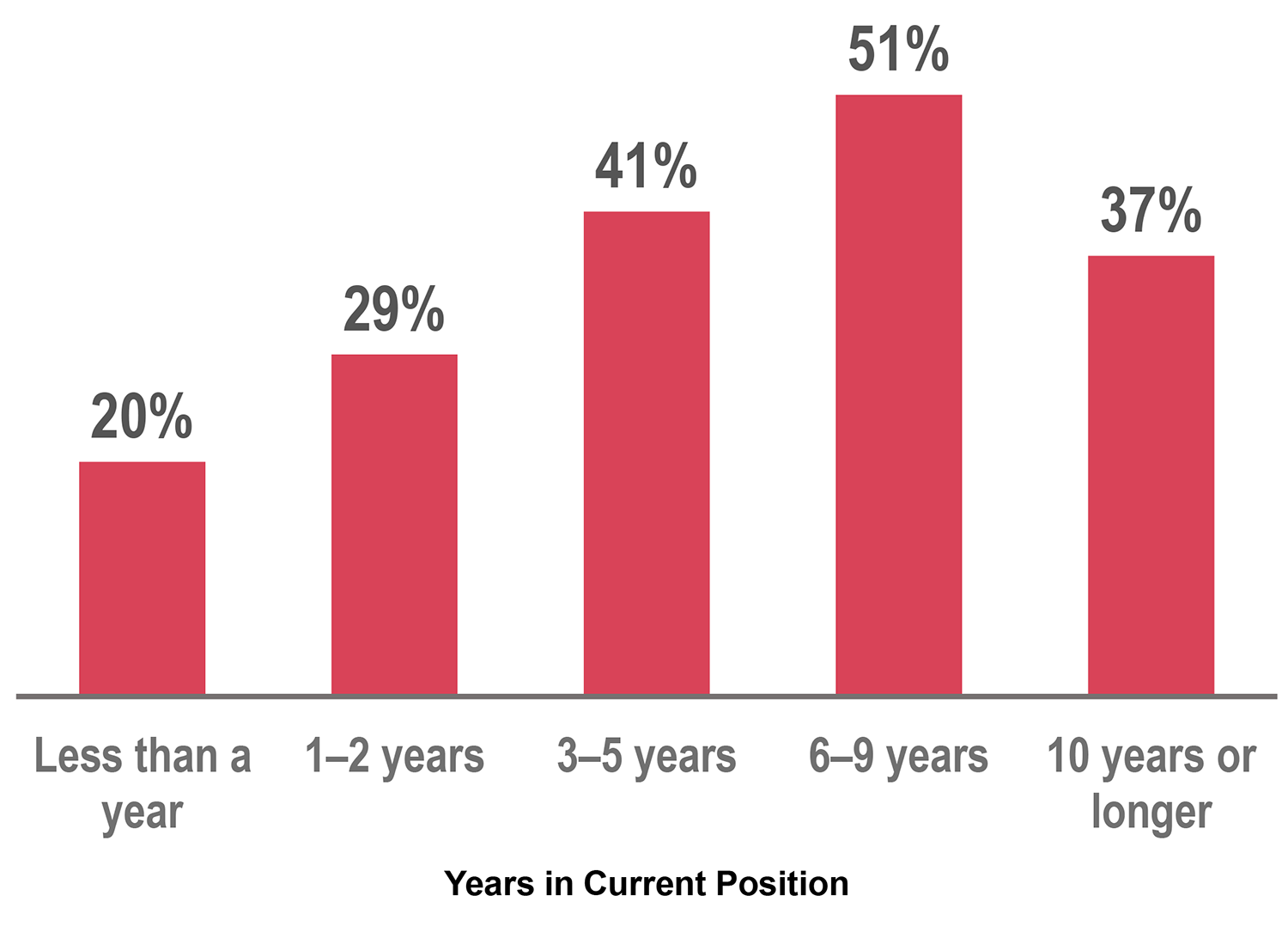A sizable wave of staff departures is headed toward higher education. Staff cite either institutional or personal reasons for staying or leaving, suggesting a range of institutional strategies for attracting and retaining talent.

EDUCAUSE is helping institutional leaders, IT professionals, and other staff address their pressing challenges by gathering and sharing data. This report is based on an EDUCAUSE QuickPoll. QuickPolls enable us to rapidly gather, analyze, and share input from our community about specific emerging topics.Footnote1
The Challenge
There's no shortage of news headlines and thought pieces on the "great resignation" that is sweeping across most industries and from which higher education is not immune.Footnote2 Less clear, though, is how many resignations there will be, why the resignations are happening, and who exactly will be resigning. Our challenge, then, is to dive deeper into these questions and to try to see around the corner to what lies ahead, better enabling our institutions and decision makers to implement policies and practices that help attract and retain the talent we need now and in the future.
The Bottom Line
The majority of respondents indicated they are either considering leaving their institution in the near future or planning to retire soon. Although reasons for staying or leaving can be deeply personal and unique to each individual, many decisions to stay or leave appear to be motivated by either institutional or personal factors. Middle-managers and middle-tenure staff, in particular, may be at risk of leaving, suggesting a number of solutions institutions might deploy to help attract and retain needed talent.
The Data: How Many Are Leaving, and Where Are They Going?
A sizable wave of staff departures could be headed toward higher education institutions. More than a third of respondents (38%) reported that they are "strongly considering" leaving their current institution for a position elsewhere or have already accepted a position elsewhere. Additionally, among those staying at their current institution, 34%Footnote3 (or 17% of the overall sample) indicated that "retiring soon" was factoring into their decision to a "moderate" or "great" extent. Altogether, then, these findings add up to more than half (55%) of our respondents who are currently thinking of leaving their institution for a position elsewhere or who are anticipating retiring soon.

Departing staff may not be headed for vacancies at other institutions. For those respondents leaving or considering leaving their institution, we asked a follow-up question about the type of job or organization they would most prefer to move into. Only 28% of respondents reported a preference for taking a position at another college or university. Half of respondents reported being open to a range of possibilities and having no preference on where they might go next, and another 13% reported a preference for taking a position outside education altogether.
The Data: Why Do We Stay, and Why Do We Leave?
It's either all about us or all about me. We asked respondents—regardless of whether they are staying or considering leaving—about the extent to which certain factors are playing a role in their decisions. Using a factor analysis to organize and understand responses, we found that respondents tended to lean toward either "institutional" reasons or "personal" reasons for staying or leaving. Although bifurcating motivations in this way risks creating silos for what in reality can be a multi-layered, idiosyncratic decision (e.g., staff with primarily institutional reasons for staying may cite some personal reasons as well), it may help provide a more nuanced framework for institutional leaders seeking to develop hiring and retention strategies that effectively address a range of factors motivating staff to stay or leave.

- Institutional reasons. People who are driven by the work and the institution care a great deal about things like the mission of the institution, the proper functioning of the institution and their team, and the nature and purpose of the work they get to do. When the institution is functioning well and the work is meaningful and impactful, it can be reason enough for some staff to stay in place, even overriding other more personal considerations like income and convenience. When the institution isn't functioning well, though, and/or the work has lost its meaning and purpose, those who care deeply about education may care too much to endure those frustrations, even if that means giving up a personally beneficial or comfortable arrangement.
- Personal reasons. For other staff, the work is perhaps a means to otherwise living a happy life outside the 9-to-5 routine, and they care more about the personal benefits and comforts their job and institution provide. When the job and institution generally fit well with their needs and desired lifestyle, it may be hard for those staff to give up a good thing, and they may even be more willing to tolerate less than ideal aspects of the work and the institution itself. When the work no longer fits what they personally need or want, however, and/or when a more attractive or comfortable opportunity comes along, they may be willing to leave despite an otherwise functional institutional environment and meaningful work.
The Data: Stuck in the Middle
Mid-level "managers" are more likely to consider leaving. Respondents who reported working at the "manager" level at their institution were more likely to be strongly considering leaving compared with respondents at other levels of the institution (see figure 3). Some staff in such "middle" positions might shoulder some of the same burdens and stressors of more senior staff at the institution (e.g., personnel management, major project accountabilities) without also enjoying the perks those other senior staff enjoy (e.g., higher pay, strategic influence, decision-making power, and agency). Indeed, "manager" respondents were more likely than respondents at other levels to identify factors such as "people/difficult relationships," "negative workplace culture," "lack of job security," "dissatisfaction with my work," and "lack of staffing or resources" as reasons for leaving, perhaps indicating greater overall stress (or a different kind of stress) in those types of managerial positions.

Staff who have been in their position for some time but not too long are more likely to consider leaving. Another category of staff we might consider being "in the middle," respondents who reported being in their current position for 6–9 years (and, to a lesser degree, those reporting 3–5 years of service) were more likely to report strongly considering leaving than respondents who've spent less or more time in their current position (see figure 4). Those staff who've been in their position fewer years may still feel new in some respects and may experience a greater sense of optimism or possibility in their role. And staff who have been in their position longer may feel a more deeply rooted commitment to staying or may be more settled in for the long haul. Those in the "middle" of their tenure might feel neither "new and optimistic" nor "long-term and rooted" and may therefore be more open to acting on discontentment with their personal circumstances and/or their job and institution.

Common Challenges
Motivations for staying and leaving are complex and hard to address. Staff and leaders may wish to find a "silver bullet" solution for attracting and retaining talent—more money, better communication—but the reality is that staying or leaving is a multifaceted, complicated decision for most staff. Even our institutional/personal framework above risks oversimplifying nuances and blurred lines between different areas of motivation, and for some staff who make the decision to leave there may simply not be enough an institution can do to understand and dissuade them from doing so.
The effects of the COVID-19 pandemic linger. While we didn't ask respondents directly about COVID-19 as a motivation for staying at or leaving their institution, the effects of the pandemic were made clear enough in respondents' comments in a number of ways. Institutional budgets have taken a hit, and wage increases have remained stagnant even though the cost of living has continued to rise.Footnote4 Institutional policies related to masking and other public health considerations may be leaving some staff feeling out of sync with their employer. These and other pandemic-related factors may very well be behind some staff motivation and decisions, and some aspects of our "great resignation" experiences may indeed be unique to this particular point in history and the extraordinary circumstances in which we currently find ourselves.
Promising Practices
Develop policies and practices that fit a range of staff motivations. Understanding that staff may primarily have either institutional or personal reasons (or some mixture of both) for staying at or leaving their job, institutional leaders might consider a two-pronged approach to exploring and developing policies and practices to help attract and retain talent:
- Institutional policies and practices. No amount of money or convenience will persuade staff to stay long at an institution that isn't functioning well and doesn't offer meaningful, satisfying work. Institutions should consider assessing and improving on leadership effectiveness in areas such as communication and strategic planning, setting and monitoring reasonable and healthy staff goals and workload capacity, and evaluating and improving team cultures and behaviors. Local workforce surveys, staff focus groups, and other approaches to gathering quantitative and qualitative staff feedback may be a good place for some institutions to begin improving in these areas.
- Personal policies and practices. The most functional places to work won't retain staff if they don't offer competitive salaries and supportive benefits that enable staff to live comfortable and happy lives. Many staff need and demand increasingly flexible work arrangements and environments, and institutional policies and practices must keep pace with emerging shifts in remote and hybrid preferences.Footnote5 Services and resources exist now that can enable institutional leaders to assess salaries and benefits and make data-informed adjustments to help stay competitive and fair.
Be intentional about supporting "middle" staff. Staff feeling "in the middle" of their institutional structure need to feel both supported by their leadership and empowered to have agency in leading their own teams and building their own work. And those staff feeling "in the middle" of their tenure at the institution need to be challenged with opportunities for growth and/or advancement, whether in the form of job changes, promotional opportunities, increased compensation, or simply institutional investment in their continued professional development and learning.
All QuickPoll results can be found on the EDUCAUSE QuickPolls web page. For more information and analysis about higher education IT research and data, please visit the EDUCAUSE Review EDUCAUSE Research Notes topic channel, as well as the EDUCAUSE Research web page.
Notes
- QuickPolls are less formal than EDUCAUSE survey research. They gather data in a single day instead of over several weeks and allow timely reporting of current issues. This poll was conducted on March 1, 2022, consisted of 16 questions, and resulted in 829 responses. Poll invitations were sent to participants through the EDUCAUSE Connect platform to groups focused on IT leadership and management. Our sample represents a range of institution types and FTE sizes, and most respondents (95%) represented U.S. institutions. Jump back to footnote 1 in the text.
- Derek Thompson, "The Great Resignation Is Accelerating," The Atlantic, October 15, 2021, and Lindsay Ellis, "The Great Disillusionment," Chronicle of Higher Education, August 25, 2021. Jump back to footnote 2 in the text.
- This figure was calculated excluding "N/A" responses to the question about whether retirement was factoring into respondents' decisions to stay at their current institution. Jump back to footnote 3 in the text.
- Susan Grajek, "EDUCAUSE QuickPoll Results: IT Budgets, 2020–21," EDUCAUSE Review, October 2, 2020. Jump back to footnote 4 in the text.
- D. Christopher Brooks and Jacqueline Bichsel, "EDUCAUSE and CUPA-HR QuickPoll Results: The Misalignment of Preferences and Realities for Remote Work," EDUCAUSE Review, September 10, 2021. Jump back to footnote 5 in the text.
Mark McCormack is Senior Director of Research and Insights at EDUCAUSE.
© 2022 Mark McCormack. The text of this work is licensed under a Creative Commons BY-NC-ND 4.0 International License.
